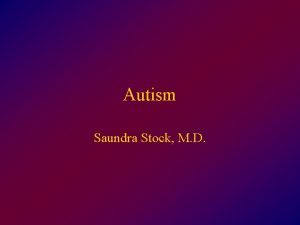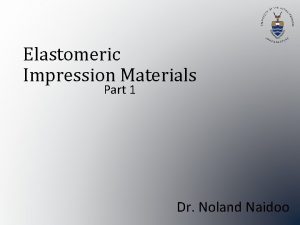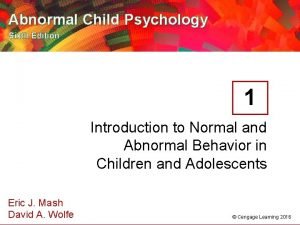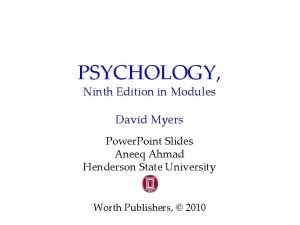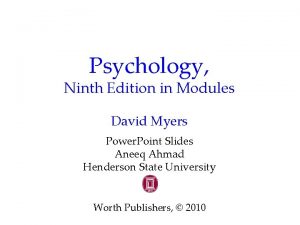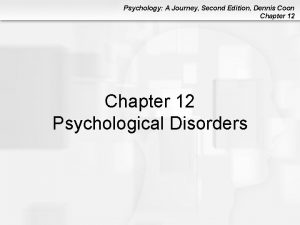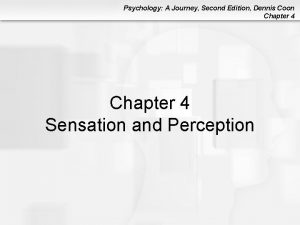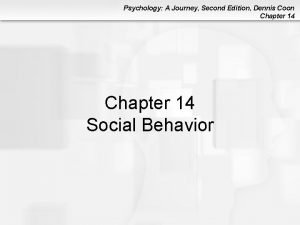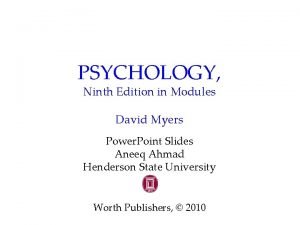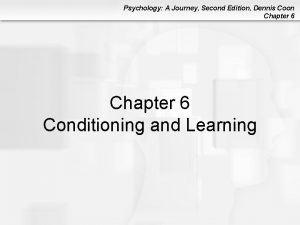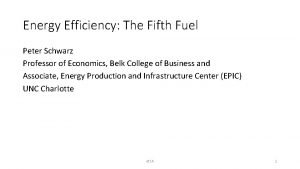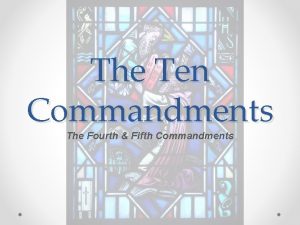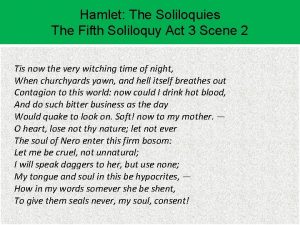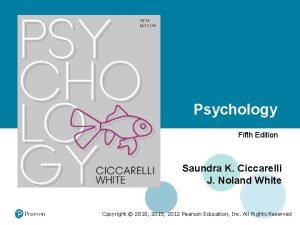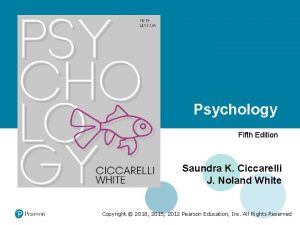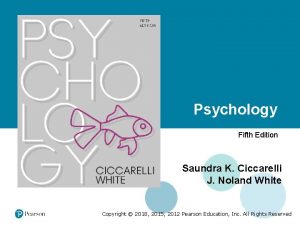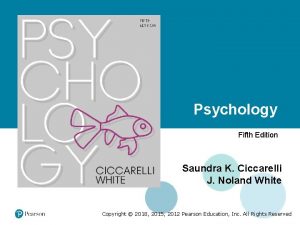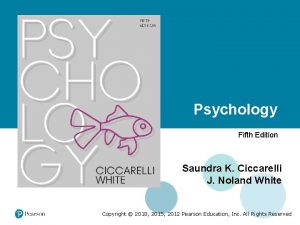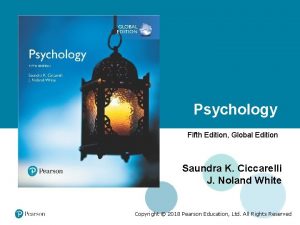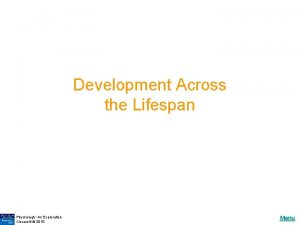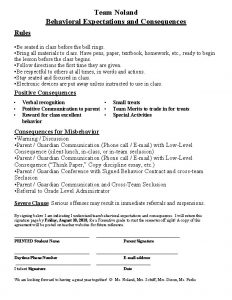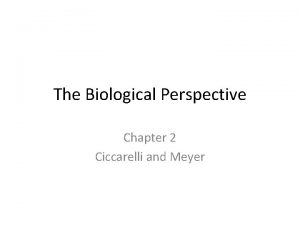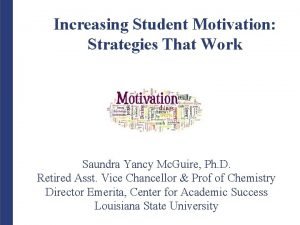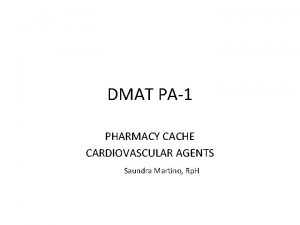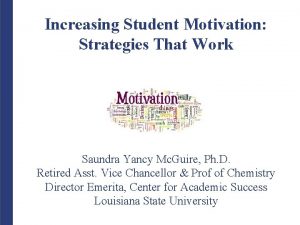Psychology Fifth Edition Saundra K Ciccarelli J Noland







































- Slides: 39

Psychology Fifth Edition Saundra K. Ciccarelli J. Noland White Copyright © 2018, 2015, 2012 Pearson Education, Inc. All Rights Reserved

Psychology Fifth Edition 11 Chapter 11 Stress and Health

Learning Objectives 1 of 2 11. 1 Distinguish between distress and eustress. 11. 2 Identify three types of external events that can cause stress. 11. 3 Identify psychological factors in stress. 11. 4 Describe the stages of the general adaptation syndrome. 11. 5 Explain how the immune system is impacted by stress. 11. 6 Describe the branch of psychology known as health psychology. 11. 7 Summarize Lazarus’s cognitive appraisal approach to stress. 11. 8 Explain how personality types and attitudes can influence people’s reaction to stress.

Learning Objectives 2 of 2 11. 9 Identify social and cultural factors that influence stress reactions. 11. 10 Distinguish between problem focused and emotion-coping strategies to stress. 11 Explain how a social-support system influences a person’s ability to cope with stress. 11. 12 Describe cultural differences in coping with stress. 11. 13 Explain how religious beliefs can affect the ability to cope with stress. 11. 14 Define mindfulness meditation and describe its use in coping with the effects of stress.

The Relationship between Stress and Stressors Learning Objective 11. 1 Distinguish between distress and eustress. • Stress: physical, emotional, cognitive, and behavioral responses to events that are appraised as threatening or challenging • Stressors: events that cause a stress reaction • Distress: the effect of unpleasant and undesirable stressors • Eustress: the effect of positive events, or the optimal amount of stress that people need to promote health and well-being

Environmental Stressors: Life’s Ups and Downs 1 of 2 Learning Objective 11. 2 Identify three types of external events that can cause stress. • Catastrophe: an unpredictable, large-scale event that creates a tremendous need to adapt and adjust as well as overwhelming feelings of threat

Environmental Stressors: Life’s Ups and Downs 2 of 2 • Major life changes: cause stress by requiring adjustment – Social Readjustment Rating Scale (SRRS): measures the amount of stress resulting from major life events in a person’s life over a one-year period – College Undergraduate Stress Scale (CUSS): measures the amount of stress resulting from major life events in a college student’s life over a one-year period • Hassles: the daily annoyances of everyday life

Table 11. 1 Sample Items From the Social Readjustment Rating Scale (SRRS) 1 of 2 Major Life Event Life Change Units Death of spouse 100 Divorce 75 Marital separation 65 Jail term 63 Death of a close family member 63 Personal injury or illness 53 Marriage 50 Dismissal from work 47 Marital reconciliation 45 Pregnancy 40 Death of a close friend 37 Change to a different line of work 36

Table 11. 1 Sample Items From the Social Readjustment Rating Scale (SRRS) 2 of 2 Major Life Event Life Change Units Change in number of arguments with spouse 36 Major mortgage 31 Foreclosure of mortgage or loan 30 Begin or end school 26 Change in living conditions 25 Change in work hours or conditions 20 Change in residence/schools/recreation 19 Change in social activities 18 Small mortgage or loan 17 Vacation 13 Christmas 12 Minor violations of the law 11 Source: Adapted and abridge from Holmes & Rahe (1967). Blank cell

Psychological Stressors: What, Me Worry? 1 of 4 Learning Objective 11. 3 Identify psychological factors in stress. • Pressure: the psychological experience produced by urgent demands or expectations for a person’s behavior that come from an outside source • Uncontrollability: the degree of control that the person has over a particular event or situation – The less control a person has, the greater the degree of stress

Psychological Stressors: What, Me Worry? 2 of 4 • Frustration: the psychological experience produced by the blocking of a desired goal or fulfillment of a perceived need • Possible reactions to frustration – Aggression: actions meant to harm or destroy – Displaced aggression: taking out one’s frustrations on some less threatening or more available target – Escape or withdrawal: leaving the presence of a stressor

Psychological Stressors: What, Me Worry? 3 of 4 • Conflict: psychological experience of being pulled toward or drawn to two or more desires or goals, only one of which may be attained • Approach–approach conflict: a person must choose between two desirable goals

Psychological Stressors: What, Me Worry? 4 of 4 • Avoidance–avoidance conflict: a person must choose between two undesirable goals • Approach–avoidance conflict: a person must choose or not choose a goal that has both positive and negative aspects • Double approach–avoidance conflict: a person must decide between two goals, each possessing both positive and negative aspects

Table 11. 2 Different Forms of Conflict Type Definition Example Approachapproach Must choose between two desirable goals. You would like to go to both Italy and England, but you can only choose to go to one. Avoidanceavoidance Must choose between two undesirable goals. You dislike both cleaning the bathroom and cleaning the kitchen but must choose one or the other. Approach– avoidance Must choose or not choose a goal that has both desirable and undesirable aspects. You want to have a pet for the companionship but don’t like the idea of cleaning up after it. Multiple Approachavoidance Must choose from among two or more goals, with each goal possessing both desirable and undesirable aspects. You have to decide on a college. One close to home would be less expensive and closer to your friends but not as academically desirable. The one in another state would be academically challenging and would look much better when applying for jobs but is very expensive and far away from friends and family.

The General Adaptation Syndrome 1 of 2 Learning Objective 11. 4 Describe the stages of the general adaptation syndrome. • Autonomic nervous system: – Sympathetic system: responds to stressful events – Parasympathetic system: restores the body to normal functioning after stress has ceased

The General Adaptation Syndrome 2 of 2 • General Adaptation Syndrome (GAS): the three stages of body’s physiological adaptation to stress 1. Alarm 2. Resistance 3. Exhaustion

Figure 11. 1 General Adaptation Syndrome 1 of 2 The diagram shows some of the physical reactions to stress in each of the three stages of the general adaptation syndrome. In the alarm stage, resistance drops at first as the sympathetic system quickly activates. But resistance then rapidly increases as the body mobilizes its defense systems. In the resistance stage, the body is working at a much increased level of resistance, using resources until the stress ends or the resources run out. In the exhaustion stage, the body is no longer able to resist as resources have been depleted, and at this point disease and even death are possible.

Figure 11. 1 General Adaptation Syndrome 2 of 2 The graph shows the relationship of each of the three stages to the individual’s ability to resist a stressor. In the alarm stage, resistance drops at first as the sympathetic system quickly activates. But resistance then rapidly increases as the body mobilizes its defense systems. In the resistance stage, the body is working at a much increased level of resistance, using resources until the stress ends or the resources run out. In the exhaustion stage, the body is no longer able to resist as resources have been depleted, and at this point disease and even death are possible.

The Immune System and Stress 1 of 2 Learning Objective 11. 5 Explain how the immune system is impacted by stress. • Immune system: cells, organs, and chemicals of the body that respond to attacks from diseases, infections, and injuries – Negatively affected by stress • Psychoneuroimmunology: the study of the effects of psychological factors on the immune system – Positive effects on immune system work only when stress is not continual and chronic condition

The Immune System and Stress 2 of 2 • Heart disease: stress puts people at higher risk for coronary heart disease (CHD) • Diabetes: type 2 diabetes associated with excessive weight gain – Occurs when pancreas insulin levels become less efficient as the body size increases • Cancer: stress increases malfunction of natural killer (NK) cell – NK cell: responsible for suppressing viruses and destroying tumor cells

Figure 11. 2 Stress Duration and Illness In this graph, the risk of getting a cold virus increases greatly as the months of exposure to a stressor increase. Although a stress reaction can be useful in its early phase, prolonged stress has a negative impact on the immune system, leaving the body vulnerable to illnesses such as a cold. Source: Cohen et al. (1998).

Figure 11. 3 Stress and Coronary Heart Disease The blue box on the left represents various sources of stress (Type A personality refers to someone who is ambitious, always working, and usually hostile). In addition to the physical reactions that accompany the stress reaction, an individual under stress may be more likely to engage in unhealthy behavior such as overeating, drinking alcohol or taking other kinds of drugs, avoiding exercise, and acting out in anger or frustration. This kind of behavior also contributes to an increased risk of coronary heart disease.

Health Psychology Learning Objective 11. 6 Describe the branch of psychology known as health psychology. • Focuses on how our physical activities, psychological traits, and social relationships affect our overall health and rate of illness • Health psychologists seek to understand how behavior can affect a person’s ability to fight off illnesses – or increase likelihood of getting sick – How do factors like poverty, wealth, religion, social support, personality, ethnicity affect health?

Cognitive Factors of Stress Learning Objective 11. 7 Summarize Lazarus’s cognitive appraisal approach to stress. • Cognitive appraisal approach (Lazarus): how people think about a stressor determines, at least in part, how stressful that stressor will become – Primary appraisal: involves estimating the severity of a stressor and classifying it as either a threat or a challenge – Secondary appraisal: involves estimating the resources available to the person for coping with the stressor

Figure 11. 4 Responses to a Stressor Lazarus’s Cognitive Appraisal Approach. According to this approach, there are two steps in cognitively determining the degree of stress created by a potential stressor. Primary appraisal involves determining if the potential stressor is a threat. If it is perceived as a threat, secondary appraisal occurs in addition to the bodily and emotional reactions. Secondary appraisal involves determining the resources one has to deal with the stress, such as time, money, physical ability, and so on. Inadequate resources lead to increased feelings of stress and the possibility of developing new resources to deal with the stress.

Personality Factors in Stress 1 of 5 Learning Objective 11. 8 Explain how personality types and attitudes can influence people’s reaction to stress. • Type A personality – – – Ambitious Time conscious Extremely hardworking Tends to have high levels of hostility and anger Easily annoyed

Personality Factors in Stress 2 of 5 • Type B personality – Relaxed and laid-back – Less driven and competitive than type A – Slow to anger

Personality Factors in Stress 3 of 5 • Type C personality – – Pleasant but repressed person Tends to internalize anger and anxiety Finds expressing emotions difficult Higher cancer rates

Personality Factors in Stress 4 of 5 • Hardy personality – Seems to thrive on stress but lacks the anger and hostility of the type A personality – Deep sense of commitment to values – Sense of control over their lives – View problems as challenges to be met and answered

Figure 11. 5 Personality and Coronary Heart Disease The two bars on the left represent men with Type A personalities. Notice that within the Type A men, there are more than twice as many who suffer from coronary heart disease as those who are healthy. The two bars on the right represent men with Type B personalities. Far more Type B personalities are healthy than are Type A personalities, and there are far fewer Type B personalities with coronary heart disease when compared to Type A personalities. Source: Miller et al. (1991, 1996).

Personality Factors in Stress 5 of 5 • Explanatory styles – Optimists: expect positive outcomes – Pessimists: expect negative outcomes – Optimists less likely to ▪ Develop learned helplessness ▪ Ignore their health ▪ Become depressed

Social and Cultural Factors in Stress: People Who Need People 1 of 2 Learning Objective 11. 9 Identify social and cultural factors that influence stress reactions. • Social factors increase effects of stress – Poverty – Job stress – Burnout: negative changes in thoughts, emotions, and behavior as a result of prolonged stress or frustration

Social and Cultural Factors in Stress: People Who Need People 2 of 2 • Acculturative stress: results from the need to change and adapt to the majority culture – Four methods of acculturation: 1. Integration: maintaining a sense of original culture while forming positive relationship with majority culture 2. Assimilation: giving up original cultural identity and adopting majority culture 3. Separation: rejecting the majority culture’s ways 4. Marginalization: maintaining no ties with original or majority cultures

Coping Strategies 1 of 2 Learning Objective 11. 10 Distinguish between problem-focused and emotionfocused coping strategies to stress. • Coping strategies: actions that people can take to master, tolerate, reduce, or minimize the effects of stressors – Problem-focused coping: one tries to eliminate the source of a stress or reduce its impact through direct actions – Emotion-focused coping: one changes the impact of a stressor by changing the emotional reaction to the stressor

Coping Strategies 2 of 2 • Meditation: mental exercises meant to refocus attention and achieve a trancelike state of consciousness and relaxation • Concentrative meditation: a person focuses the mind on some repetitive or unchanging stimulus so that the mind can be cleared of disturbing thoughts and the body can experience relaxation

How Social Support Affects Coping Learning Objective 11. 11 Explain how a social-support system influences a person’s ability to cope with stress. • Social-support system: the network of family, friends, neighbors, coworkers, and others who can offer support, comfort, or aid to a person in need – Marriage – Role of gender

How Culture Affects Coping Learning Objective 11. 12 Describe cultural differences in coping with stress. • Different cultures perceive stressors differently • Coping strategies will also vary from culture to culture

How Religion Affects Coping Learning Objective 11. 13 Explain how religious beliefs can affect the ability to cope with stress. • People with strong religious beliefs also have been found to cope better with stressful events

Coping with Stress Through Mindfulness Meditation Learning Objective 11. 14 Define mindfulness meditation and describe its use in coping with the effects of stress. • Mindfulness meditation: a form of concentrative meditation in which the person purposefully pays attention to the present moment, without judgment or evaluation
 Schachter singer theory
Schachter singer theory Saundra stock md
Saundra stock md Advantages and disadvantages of addition silicone
Advantages and disadvantages of addition silicone Chuck noland
Chuck noland Principles of marketing fifth european edition
Principles of marketing fifth european edition Molecular biology
Molecular biology Fundamentals of corporate finance fifth edition
Fundamentals of corporate finance fifth edition Human anatomy fifth edition
Human anatomy fifth edition Democritus atomic model diagram
Democritus atomic model diagram Human anatomy fifth edition
Human anatomy fifth edition Molecular biology of the cell fifth edition
Molecular biology of the cell fifth edition Stephanie ciccarelli
Stephanie ciccarelli Devco organigramme
Devco organigramme Gianni ciccarelli
Gianni ciccarelli Using mis (10th edition) 10th edition
Using mis (10th edition) 10th edition Using mis 10th edition
Using mis 10th edition Equifinality psychology
Equifinality psychology Social psychology ninth edition
Social psychology ninth edition Psychology ninth edition in modules
Psychology ninth edition in modules Psychology a journey 4th edition chapter 1
Psychology a journey 4th edition chapter 1 Psychology
Psychology Psychology a journey 4th edition chapter 1
Psychology a journey 4th edition chapter 1 Psychology ninth edition in modules
Psychology ninth edition in modules Psychology tenth edition david g myers
Psychology tenth edition david g myers Lysanx
Lysanx Psychology a journey 4th edition chapter 1
Psychology a journey 4th edition chapter 1 Psychology eighth edition david g myers
Psychology eighth edition david g myers Psychology ninth edition in modules
Psychology ninth edition in modules General adaptation syndrome
General adaptation syndrome Psychology a journey 4th edition chapter 1
Psychology a journey 4th edition chapter 1 Introspection method of psychology
Introspection method of psychology Positive psychology ap psychology definition
Positive psychology ap psychology definition Social psychology is the scientific study of
Social psychology is the scientific study of Mere exposure effect psychology
Mere exposure effect psychology Health psychology definition ap psychology
Health psychology definition ap psychology Fundamental attribution error ap psychology
Fundamental attribution error ap psychology The fifth fuel
The fifth fuel Gods commandments
Gods commandments 3 4 pharyngeal pouch
3 4 pharyngeal pouch Fifth soliloquy of hamlet
Fifth soliloquy of hamlet

